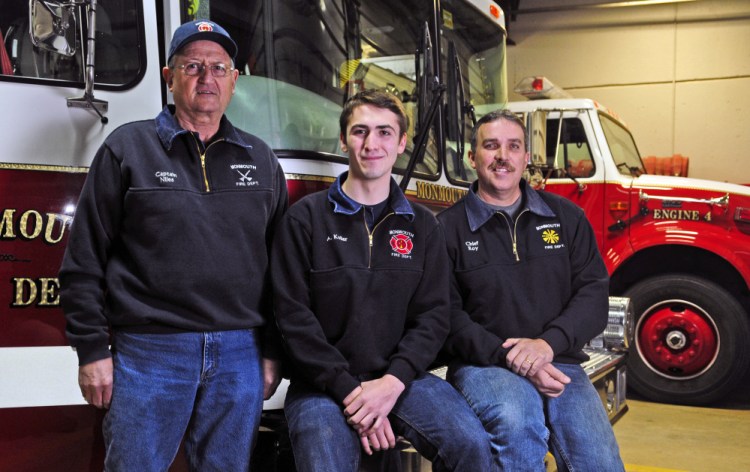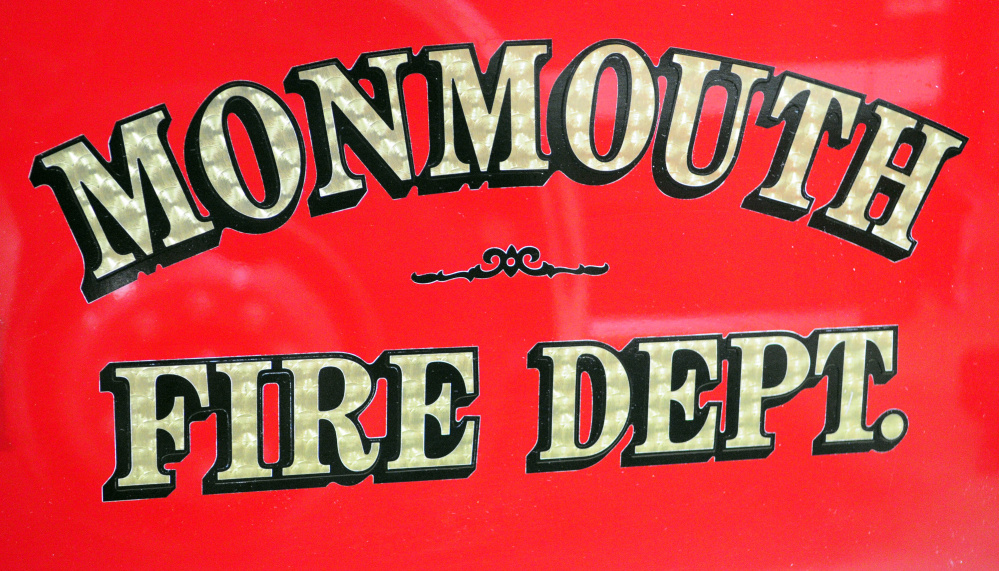MONMOUTH — While volunteer fire departments around the state struggle to attract even a handful of men and women willing to donate their time to training and responding to crashes, fires and other major incidents, Monmouth Fire Chief Dan Roy’s typed roster of volunteers fills the better part of a full page.
As state lawmakers gather in Augusta to consider various bills aimed at boosting sagging volunteer numbers, they may want to take a look to their west, to Monmouth. Roy makes no claim to having the answers legislators seek, but he knows what has worked in his town, where there is not only a healthy flow of new volunteers and long-time commitment, but a thriving junior program and strong community connection.
“I have 20 to 25 guys I’ll average on an incident like a structure fire or a bad crash,” Roy said. “If it’s a night or weekend, we’ll turn out 35.”
Tim Theriault, fire chief in China, which has a population similar to Monmouth, has 22 volunteer firefighters with about 13 he describes as active. Theriault, who’s also the District 79 state representative, last week said the state’s shortage of volunteers is a “crisis” that is creating dangerous situations for many of the state’s departments.
Roy, meanwhile, has a roster of 55 firefighters, at least 30 of whom he describes as active. That roster includes officers — assistant chiefs, captains and lieutenants — and four supporting members who fulfill various roles but do not train or respond to incidents. Monmouth’s firefighters are paid $9.48 per hour while responding to emergency calls, though they are not paid for training sessions, public events or other acts of service.
The roster also includes 10 junior firefighters between the ages of 14 and 18.
“The training sessions will have 25 to 30 people. That’s amazing,” Roy said. “A lot of small towns like ours have maybe 30 people on the roster, then half show up. We’re double or triple that. It’s a reflection of our department, our training and the commitment of the firefighters.”
Theriault serves on the Maine Fire Protection Services Commission, which is brainstorming ideas to attract volunteers. The commission is recommending that the Legislature consider providing volunteers with workers compensation coverage, tax credits at the state level, eligibility for state employee health insurance programs, forgiveness of student loans and providing retirement benefits.
China’s firefighters are entirely unpaid volunteers. The Maine Fire Marshal’s Office says nearly 5,700 firefighters in the state received some sort of pay in 2014 while just 560 were unpaid volunteers.
The commission is also recommending that the Legislature assist in providing more support for small departments by establishing a firefighting training facility, funding grants for municipalities and their fire departments, funding a statewide database for personnel and establishing another fire marshal position.
Roy said he supports the legislation.
“What they’re trying to push through is very important,” he said.
But Monmouth has not experienced the same dearth of volunteers thanks in part, Roy says, to a strong leadership core, a training schedule designed to keep volunteers engaged and a junior firefighter program that offers an early taste of firefighting.
STARTING YOUNG
The junior program, which Roy said could have more members if it were not capped at 10, has grown in popularity in recent years due, in part, to Roy’s effort to improve the connections between the junior and regular volunteers. The juniors, for example, have their own officers in charge of the group and recently started holding their own monthly meetings. The junior volunteers take part in all the training alongside the regular volunteers. Juniors are prohibited from entering burning buildings, directing traffic or working in the “hot zone” where there is a danger posed by flames or falling debris, but they can fill various key roles, like spraying water while standing outside the hot zone, fetching tools and equipment for the regular volunteers or filling air tanks. Roy said using juniors to carry out those vital tasks frees up regular volunteers to do the jobs the juniors are not allowed to do.
“The junior program is extremely important,” Roy said. “That is one of the key fundamentals to why Monmouth has been successful in maintaining a healthy roster.”
Roy has taken steps to keep the juniors engaged, like assigning officers to work with them, planning outings to visit different departments and agencies, and he even includes them in socializing, like when the firefighters gathered for breakfast after a recent late-night fire.
“It makes them feel like part of the team,” Roy said.
Angus Koller, 18, who served with the junior volunteers during all four years at Monmouth Academy, said that integration was key to holding his interest and attracting others to the program. He recalled a training early on where he practiced search and rescue and putting on turnout gear.
“This is just such a cool experience,” he said. “They really try to get you involved.”
When the juniors turn 18, they can become regular volunteers. Many stay with the department, Roy said. Even if they go away to college, they remain active and on call when home on breaks. At least a few of the juniors have enrolled in programs to become full-time firefighters.
“By then they’ve been through all our mandatory training,” Roy said. “They’ve had four years of active training with us.”
Koller, last year’s junior firefighter of the year, served as captain of the junior program and is now a regular volunteer when he is home on break from the University of Maine.
Koller said he would never have joined the fire department if not for the junior program.
“The quality of the training is really impressive,” he said.
Koller and one other junior graduated last year.
“We had people lining up to take those spots from us,” Koller said.
Roy said support from the community and the school, which allows the students to leave to answer significant calls, like a structure fire, is vital in the junior program’s success.
“What better incentive for a junior than to get out of school if there’s a structure fire,” Roy said, smiling. “When the kids find that out, everyone wants to sign up.”
Capt. Dan Niles joined the junior program in 1964 and has been with the department ever since. Niles said the camaraderie has kept him coming back. Nearly half of the department’s 55 volunteers have 20 or more years of service.
“People are willing to work very well together,” Niles said. “And it’s a way of helping out the community.”
MORE TRAINING
Niles said he cannot recall a time when Monmouth has struggled to attract volunteers. He said community functions, like regular breakfasts and coloring programs at the elementary school where the grand prize is a ride to school in a fire truck, help create a connection to the community.
“People want to become part of it,” Niles said. “It’s because of our leaders. They keep the ball rolling and keep things interesting.”
Roy sees maintaining interest as part of his job. Accomplishing that, ironically, means more training, not less. Most departments train once per month, but Monmouth trains twice per month. The extra sessions allow the volunteers to carry out all the mandated training and leaves time for optional sessions. Roy tries to schedule all the classroom training for the winter months when nobody wants to be outside. By the time the warmer months arrive, the inside sessions are complete and the volunteers can do the more engaging outdoor training.
“Come spring we can go outdoors and do stuff that’s more fun for the guys,” he said. “You break it up and have more opportunity to have fun.”
Roy also schedules optional trainings every year, including a yearly trip to the National Fire Academy in Maryland.
“It’s been a great experience for the guys,” he said.
Roy, who is self employed as a fire investigator, said his department also benefits from a healthy dose of volunteers who work in the community or are self employed with flexible schedules. One of the forces driving down volunteer services across the state are the number of men and women who work outside their home communities.
“We’ll get more than a dozen people for a daytime call,” Roy said. “A lot of departments struggle to get half of that.”
Roy said the department also has benefited from support from town officials as well as the public. The department hosts three breakfasts per year that attract a couple hundred people. The department also has an active Facebook page that keeps followers up to date on the department’s activity.
“We get a lot of feedback from our citizens,” Roy said. “I get a lot of personal satisfaction from hearing those comments. People like to see their department. They like to see what we’re doing.”
Assistant Fire Chief Ed Pollard said Roy is as proactive in keeping his firefighters informed as he is the community. Roy gives his firefighters weekly progress reports that often include pictures. Pollard said much of the credit for the department’s healthy roster is due to leadership, and that all starts with Roy.
“Men and women will follow him anywhere,” Pollard said. “It’s about leadership. I keep trying to tell him that he keeps downplaying his own role.”
Koller said he plans to continue to serve as a volunteer firefighter through college and beyond, whether that is in Monmouth or elsewhere.
“It’s great to give back to your town,” he said. “I think this is an amazing way to do it. I’d love to do this as long as I can.”
Craig Crosby — 621-5642
Twitter: @CraigCrosby4
Send questions/comments to the editors.



